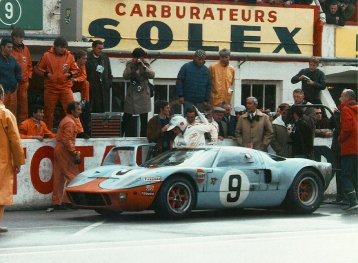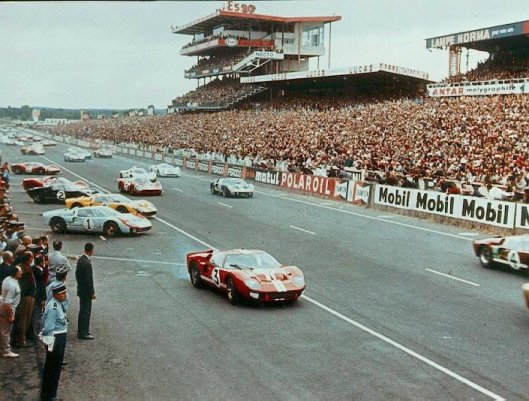| Racing with Shelby American | Ken Miles | |
| 1964 The Beginning Part 1 | MkII – 1966 the 427 Part 3 | |
| 1965 Shelby Takes Over Part 2 | 1967-68-69 Part 4 |
The Beginning of the GT 40 Story

Ford wanted some racing victories in the early 60’s. The leadership at Ford reasoned the easiest way to win races was to buy a company that was already winning, like Ferrari. Ford made an offer to Enzo Ferrari to buy his production facilities and racing operation. The deal was Ford would take over the manufacturing of the production cars and Enzo would continue to run the racing operation. Enzo dragged his feet. He said he needed for more time to think about it. When he came back to Ford, he had some conditions for the deal. Condition number one was Ford would stop offering support to that upstart Carroll Shelby. By this time Ford was already having second thoughts about the whole deal.
The deal to buy out Ferrari fell through. Even if a Ferrari carried a Ford flag, it wouldn’t quite have been the same as a Ford winning. Carroll Shelby’s Cobras were winning races in the early 60’s but the Cobras were hybrids, not true Fords. The engines may have been Ford but the body was English. The leadership at Ford wanted a Ford to win races.
Ford Advanced Vehicles was created. A team was sent to LeMans in 1963 to witness the race and view the competition. That team included Carroll Shelby. Ferrari took the first 6 places, a Shelby American Cobra placed 7th and an independent Cobra completed half the race.
The next project was to find a body. These were the days before computerized design and wind tunnels. At a car show in England, an Englishman named Eric Broadley displayed a Ford powered body he called the Lola GT. The body was very aerodynamic, the roof was only 42″ off the ground. The construction was very unique for a race car, it was a uni-body. The car did not have a frame as other cars did. Instead, the body was one piece forming the frame of the car. The term uni-body was used to describe the car.
Broadley signed a two-year contract with Ford. John Wyler, an Englishman, was named team manager. (Wyler was in charge of the Aston Martin team that Carroll Shelby had won the 1959 LeMans with.) Shelby was brought in to run the project PR, race the GT40’s in the US and market the street version of the car.
Broadley’s design was put to wind tunnel tests at the University of Maryland. Ford engineers redesigned the body to fit specified chassis dimensions. Air scoops were put on both sides (also found on the 1962 Mustang I Ford developed.) Originally the scoops were to duct air into side mounted radiators. Not enough air entered the scoops to make a difference for the radiators, so they were redesigned to cool the rear brakes.
The interior had flow-through ventilation designed by Ford to cool the interior. An aluminum 4.2 liter F.A.V. (256 CID) Fairlane V-8 powered the GT40. With four Weber carbs, the engine put out over 350 horsepower. A 4-speed trans-axle (Colotti type 37) put the power to the wheels. This was the only one of its kind available.
Ten months later, two GT 40s were shipped to Nurburging for their first race. But the GT40 target was the 24 Hours of LeMans in April. Three GT40’s were prepared for LeMans. The GT40’s were far from successful. Early in the race there was little doubt the GT40’s were the fastest cars on the track. The Ginther/Gregory GT40 lasted six hours before the transmission took it out of the race. The Collotti 4-speed was plagued with problems. The engines weren’t reliable either. During the 1964 season the GT40’s had 10 starts and 10 DNFs (Did Not Finish). The team was demoralized. Broadley quit.

At the 1964 Nassau Speed Week, the last time a Ford team raced the two GT40’s, both cars had suspension failures. They were poorly prepped, primarily due to lack of enthusiasm. The car, driven by Bruce McLaren, lasted three laps of the preliminary Tourist Trophy race and was parked. The Phil Hill GT40 did better. It came in third in the preliminary race and went out in the 17th lap of the next race. Neither car was entered in the main race, the Governor’s Cup.
The GT40’s proved they could win. On the track, they were awesome. But winning races meant finishing them. An experienced hand was needed. Carroll Shelby and his Shelby American team were the logical choice to take over the project. Besides, Shelby American Cobras were winning the races against the GT40’s. The two cars were shipped by TWA air freighter “as is” from Nassau to Los Angeles, California, in December 1964. Before anything could be done with them they had to be cleaned up. They were a mess on arrival.